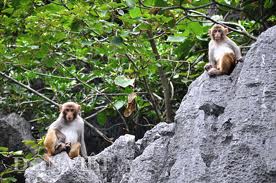Halong Bay biological diversity

Hạ Long Bay has a very complicated structure with its meandering coastline and many river mouths. Rich and diversified sources of food for many species of plants and animals are also found here. In particular, the bay, partitioned by thousands of large and small islands, creates areas of water with an average and stable sea level. Meanwhile, the climate in Hạ Long Bay is also very stable, with an average temperature of between 19 and 25ºC, and an average heat radiation rate of 17 kcal/ sq. cm/ month. It sees an average rainfall of 2,000 to 2,200 mm/ year. These favourable conditions have seen the development of many varied ecosystems.
Results of scientific research show that Hạ Long Bay features ecosystems of a tropical ocean region, such as: salt water-flooded forests, coral reefs and tropical rain forests.
In the sea surrounding Hạ Long, coral grows in many places, but is densely concentrated on the eastern and southern sides, far from the mainland. According to research conducted by scientists from the Oceanographic Institute, Hạ Long Bay is home to 163 species of coral, from 44 lines of descent and 12 families. Coral reefs are distributed everywhere, generally at a depth of 4 to 6m. The coverage rate of coral reef is 30% on average, but there are areas where it attains 70 to 80%, such as at Cống Ðỏ and Bọ Hung. The coral forests of Hạ Long Bay are a wonderful sight, with many extraordinary shapes and diversified colours. When the tide flows, the coral moves with the water, pumping as rhythmically as a heartbeat. At the same time, the reefs are residence to a great number of species: fish (107 varieties), water plants, algae and transitory animals and plants.
The salt water-flooded forests also offer especially interesting scenery along the coastline of Hạ Long Bay. These forests are chiefly concentrated in the zones of Tuần Châu, Cửa Lục and Ba Chẽ. Many species of salt water-flooded plants, the most diversified collection in North Vietnam, are found here. Also living in these flooded forests are a great many species of animals: migrating birds (37 species), sea-bottom animals (81 species) and fish (90 species belonging to 55 families). In particular, bottom-feeders account for 61% of the total species in the whole tidal region, with many species being of great economic value: arcae, meretrixes and all kinds of crustaceans.
The tropical rain forest ecosystem also features a rich quantity of species: đinh, hương, sến, táu trees. This is the residence of various rare and precious creatures: deer, weasels, squirrels and in particular, white-tabby and red-haired monkeys.
At the same time, there is a system of small caves along the sea, which are the living and development places for many animals and plants: seaweed, water plants, algae, fish and shrimp. Deeper into the water, there are also many species of shrimp, fish (almost 1,000 species), abalone and other sea-specialities; harvested every year to the tune of several thousand tons.














